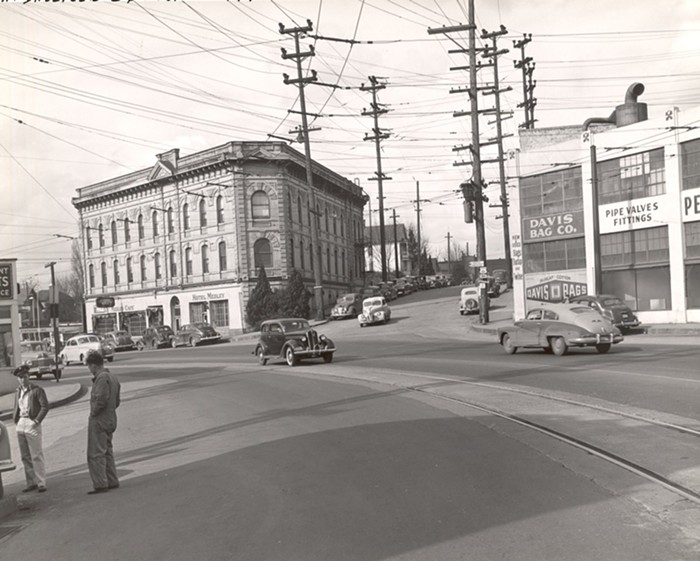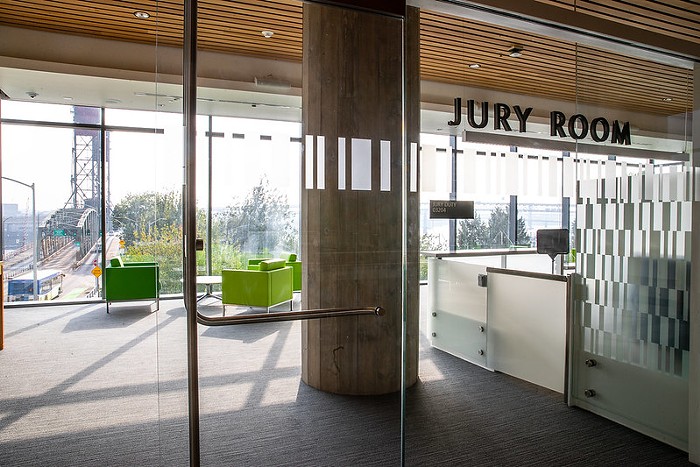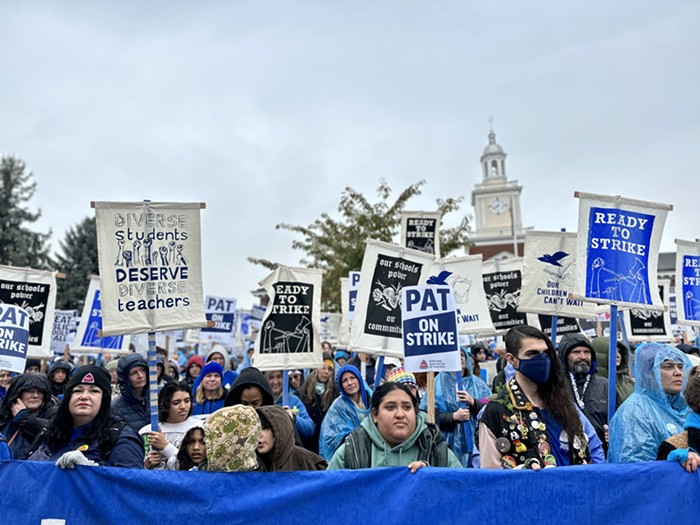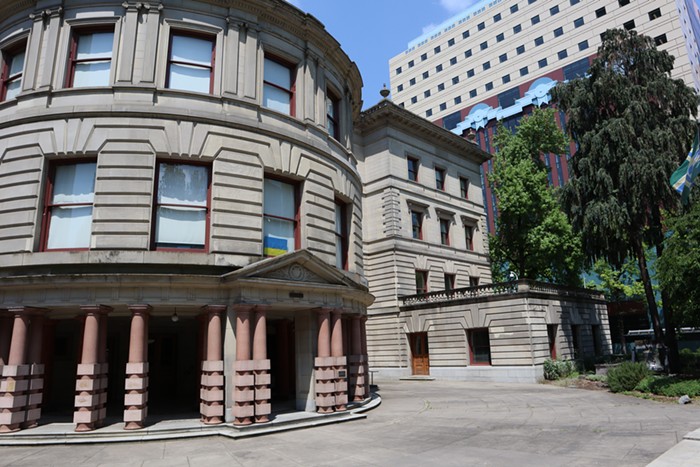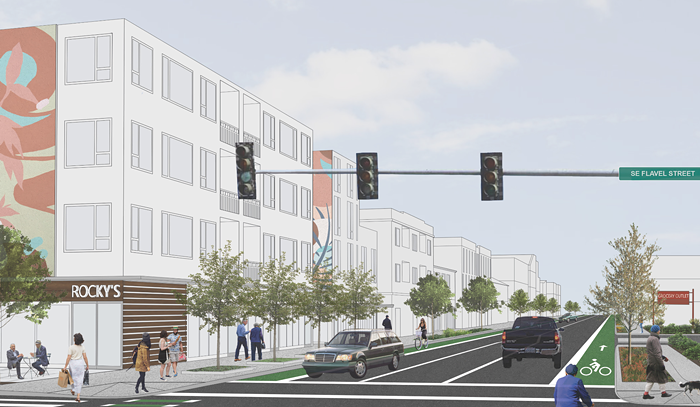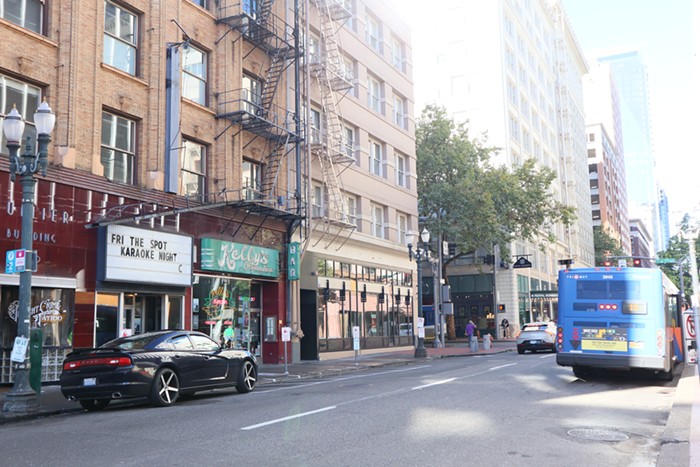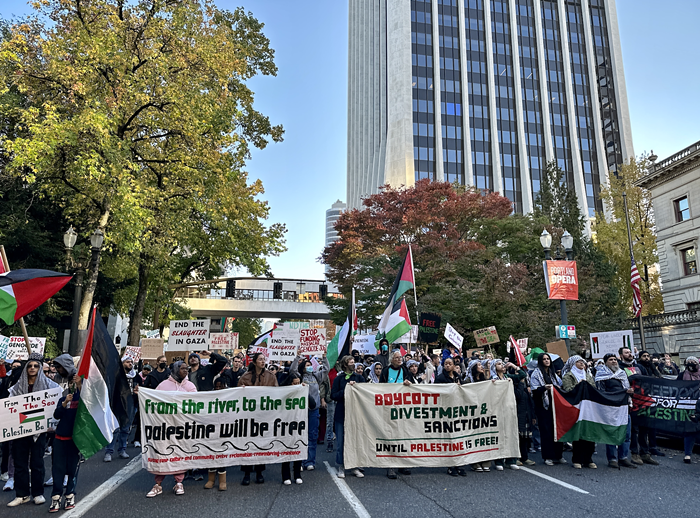In the 1940s, the Northeast Portland neighborhood of Albina was an anomaly. In a city with a vast majority of white residents, the tight-knit neighborhood was a thriving hub for Black culture, politics, and social life.
But in the late 1950s and 1960s, Albina lost that splendor. The City of Portland leveled hundreds of African American-owned homes to make room for the Memorial Coliseum, the Rose Garden (today known as the Moda Center), and a new stretch of I-5—prompting a drop in Albina’s Black population, which is still declining today.
“Albina was thriving,” says Winta Yohannes, the managing director of the Albina Vision Trust (AVT), an organization that aims to restore Albina’s identity as a thriving multicultural center. “It’s unimaginable to think that [the I-5 would have been put there] if it were not an African American community.”
Yohannes and others at AVT see an opportunity to jumpstart their vision by endorsing an Oregon Department of Transportation (ODOT) plan to widen and cover a stretch of I-5. By capping and landscaping the space above the interstate highway and devoting it to community use, AVT believes the Albina neighborhood could be restored, 70 years after I-5 was built.
But making this plan a reality will require AVT to work closely with ODOT, one of the entities responsible for dismantling Albina in the first place. The plan to add freeway covers is part of a larger, controversial ODOT plan, the Rose Quarter Improvement Project, that aims to add two new traffic lanes to the stretch of I-5 that passes through Portland’s Rose Quarter, an area that overlaps with the Albina Neighborhood.
While AVT has been working with ODOT for over a year to make sure ODOT’s project aligns with the organization’s vision for a reconnected Albina, the group has reservations about how negotiations have been going up until now—and the project faces fierce scrutiny from other Portland leaders. With a crucial vote about the future of that project drawing near, AVT’s mission has placed it squarely in the middle of a political fight that, in addition to ODOT, includes local elected officials, environmental and transportation activists, and school district administrators.
“It’s universally acknowledged that the original I-5 physically divided the community, and it facilitated the loss of millions of dollars [in community wealth],” says Yohannes. “The reason that happened is because ODOT, at that time, didn’t take into account the community that was already there. That can’t happen again.”
“Quite frankly, in some ways in my community, it’s seen as reparations for some of the things that have taken place in the past."
Albina was created by racist Portland policies. It was also destroyed by them.
The neighborhood—most of which overlapped with what Portlanders know today as the Eliot, Boise, Humboldt, Irvington, King, Overlook, and Piedmont neighborhoods—was annexed into the city of Portland in 1891. Prior to annexation, Albina was controlled by the Union Pacific Railroad, which used it to house many of the African Americans who worked on the railroad. In 1919, the Portland Realty Board adopted a policy declaring it unethical to sell property to a Black person in a white neighborhood—and because Albina was already seen as a Black neighborhood, it was virtually the only part of the city where African Americans could own property. Its Black population grew steadily over the first half of the century.
By 1960, approximately 80 percent of Portland’s Black population called Albina home. Photos and firsthand accounts depict the neighborhood as a thriving, dynamic cultural center. It was also home to a wave of German immigrants, who lived alongside the neighborhood’s Black residents in a way most white Portlanders refused to do.
But just as the Black population in Albina was reaching its peak, new federal funding became available for housing and transportation projects—opening the door for Portland and ODOT to seize Albina property and use it to their own advantage. With Interstate 5 cutting through Albina, the city designated parts of the neighborhood as “blighted” so it could receive funding to tear down existing homes and convert the property for commercial use, like building the Memorial Coliseum, which broke ground in 1959. The Coliseum remade the area as Portland’s hub for professional sports; in 1993, an even larger arena was built next door.
Albina’s Black population steadily declined in the decades following the property seizures, and as the area was rebuilt with new apartment buildings, business, and services, it attracted white residents who had previously lived in Portland’s suburbs. Census data shows that between 2000 and 2010, nearly 10,000 people of color moved out of Portland’s city center. During that time, 10 census tracts in Northeast Portland, including many of those that make up Albina, flipped from having minority-majority populations to majority white populations.
In 2015, a series of community conversations in Northeast Portland led to the creation of the AVT, and the group established a 50-year plan for the neighborhood, which includes creating community access to the Willamette River, building a public event plaza, and adding new affordable housing developments—along with building covers over I-5 that would connect areas of the neighborhood divided by the freeway. AVT envisions these covers as being a dynamic part of the new Albina, and being strong enough to support multi-story residential buildings.
Decades in the making, ODOT’s plan for widening I-5 also includes covers for the highway. Not wanting ODOT’s project to take off without its involvement, AVT has become a central player in the planning for the Rose Quarter Improvement Project, which has ramped up over the last year.
State Senator Lew Frederick, whose district includes Albina, sees the covers as a necessary part of the project.
“Quite frankly, in some ways in my community, it’s seen as reparations for some of the things that have taken place in the past,” Frederick said at a February hearing on the project in Salem.
But when ODOT released preliminary project designs for the covers last year, they landed with a thud. ODOT’s proposed freeway covers wouldn’t be capable of supporting multi-story buildings—a disappointment for AVT, as well as transportation and environmental advocates. Yohannes says that the current cover designs would only create “unusable empty space.”
“I think we were all disappointed when we saw what those designs looked like,” says Chris Smith, a longtime transportation advocate and current candidate for Metro Council. “They’re really not useful for anything.”
Smith was present for preliminary conversations between ODOT and the City of Portland in 2012. He says ODOT’s lackluster plans for the covers don’t match up to the promises its officials made during those meetings.
But for Smith and other Portlanders involved in the planning process, the lack of vision on the freeway covers is only one of several problems with the proposed project.
Smith belongs to local environmental coalition No More Freeways, which staunchly opposes the addition of additional freeway lanes. Recent studies have found that adding more lanes to freeways increases both traffic and greenhouse gas emissions, and Smith argues the dedicated state funding for the project “should be spent somewhere else, on a different way of moving people”—like public transportation, bicycle infrastructure, or safer pedestrian walkways. Because funding for the I-5 expansion project was already earmarked in a 2017 state transportation bill, any redirection of funds would likely require action from the Oregon State Legislature or Governor Kate Brown.
Numerous local elected officials from Portland City Council, Metro Council, Multnomah County Board of Commissioners, and Portland Public Schools (PPS) have joined with AVT in criticizing ODOT’s current cover design and objecting to what they see as the agency’s lack of engagement with local leaders on the project. Criticism has twice prompted ODOT’s overseeing body, the Oregon Transportation Commission (OTC), to delay a vote on whether the project should move forward now or be subject to a more rigorous environmental review—something AVT, PPS, and local elected officials have called for.
“The OTC has yet to articulate how our input would be addressed or how our recommendations would be incorporated,” local officials wrote in a December letter to ODOT, in which they noted their questions about the project’s equity and environmental impacts. “We continue to have concerns about the stewardship and outcomes of the Project.”
The OTC is expected to finally vote on the project’s future at its March 20 meeting. Update, March 12: The decision has once again been delayed, this time due to Governor Kate Brown's ban on large public gatherings to stop the spread of COVID-19. The decision will now be made during a phone meeting in April.
“We understand earning trust will take time."
While united in opposition to the current covering design, AVT and No More Freeways are divided in other areas. The two groups agree that ODOT needs to dedicate more funding to build covers capable of supporting large buildings, but No More Freeways wants to see the lanes taken out of the plan altogether.
“We don’t see any need to widen the freeway to accomplish what Albina Vision wants to accomplish,” says Smith.
But Yohannes says that the project can reduce greenhouse gas emissions while still including the auxiliary lanes. She points to congestion pricing, in which roads are tolled during times of high traffic, as one way of achieving that. That’s a tool that Metro Council President Lynn Peterson also wants to see incorporated in the project, and it’s being actively explored by Oregon House Speaker Tina Kotek.
“We’re asking to put [our plan for Albina] into the context of the opportunity,” Yohannes says. “Because the alternative is the status quo.”
At a meeting in January, OTC voted on a package of measures meant to ease negotiations on the Rose Quarter project between state and Portland leaders. As a result, ODOT commissioned a third-party report to evaluate the cost of building stronger covers for I-5 that could support more infrastructure. OTC also directed the agency to form two local advisory committees for the project, and establish a document laying out agreed-upon values that will guide the rest of the process.
“This is a significant step in establishing partnerships and will inform the larger community discussion about the project,” Brendan Finn of ODOT writes in an email to the Mercury. “That said, this is a first step and we will need to continue down this path of partnership.”
Finn was recently named the director of a new ODOT office, called the Office of Urban Mobility and Mega Project Delivery. The office, responsible for overseeing the Rose Quarter project, was created to expand ODOT’s focus to include social equity components in their infrastructure projects.
“We understand earning trust will take time,” Finn writes. “That starts with acknowledging historic injustices, being clear and intentional about our path forward, and not assuming we know the needs of the community.”
Yohannes calls the creation of the office, and the appointment of Finn as its director, “a good step” toward establishing trust between ODOT and AVT. Unlike the No More Freeways coalition, AVT plans to continue working with ODOT, rather than working to stop the project.
“I think it’s important Albina Vision continues to come to the table,” Yohannes said. “We want [ODOT] to articulate: What are the outcomes to this project, and how do they align with our community values?”
With the March 20 vote just weeks away, Yohannes has hope that freeway covers like the ones AVT envisions will become part of the project.
“This is doable,” she says. “I hope that becomes the prevailing sense of this project—that we actually can rise to the challenge.”
